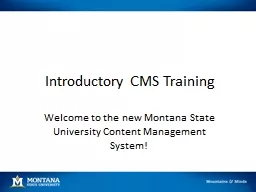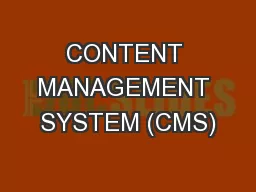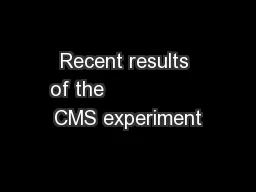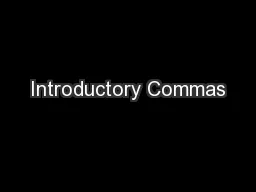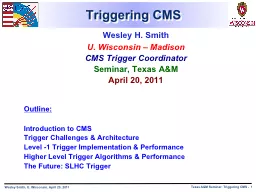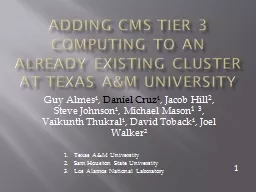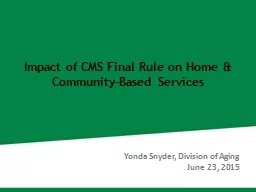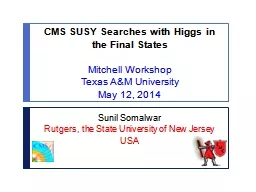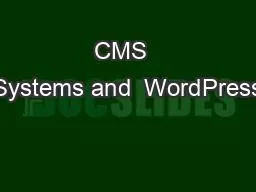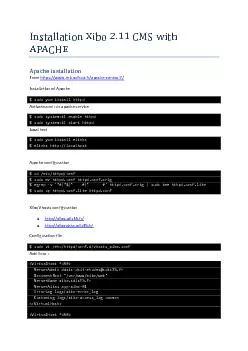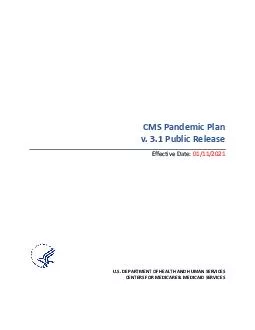PPT-Introductory CMS Training
Author : debby-jeon | Published Date : 2015-11-06
Welcome to the new Montana State University Content Management System Getting Started Lets get started httpoumontanaeducmstraining Key concept staging vs published
Presentation Embed Code
Download Presentation
Download Presentation The PPT/PDF document "Introductory CMS Training" is the property of its rightful owner. Permission is granted to download and print the materials on this website for personal, non-commercial use only, and to display it on your personal computer provided you do not modify the materials and that you retain all copyright notices contained in the materials. By downloading content from our website, you accept the terms of this agreement.
Introductory CMS Training: Transcript
Welcome to the new Montana State University Content Management System Getting Started Lets get started httpoumontanaeducmstraining Key concept staging vs published Our CMS is a push CMS it pushes or publishes to the public web server when YOU are ready. Kajari. . Mazumdar. Link-person (NOT Spokesperson), India-CMS collaboration. July 28 – 29, 2011 . BARC, Mumbai. News from LHC, CMS. Issues concerning India-CMS. Pledges. . Conferences. By Joseph Stern . Are Custom Coded Websites Dead? . Why Use a CMS?. CMS . is simply just a pre-built system from . which to . build a website that includes. :. Content . Creation. . Content . Management. QFTHEP2015. The . 22. th. International . Workshop on . High Energy Physics and Quantum Field Theory, Samara (Russian Federation). Dr. Bora Akgün . –. Rice University. (. on behalf of CMS Collaboration. Sospi Thomas. Bay Mills Community College. December 1, 2009. Introductory Comma Rules. Use comma when word, phrase, or clause is in beginning of the sentence.. Introductory Comma Chart. Correct Sentences Using Introductory Commas. Wesley H. Smith. U. Wisconsin – Madison. CMS Trigger Coordinator. Seminar, Texas A&M. April 20, 2011. Outline:. Introduction to CMS . Trigger Challenges & Architecture. Level -1 Trigger Implementation & Performance. texas. . a&m. university. Guy Almes¹, . Daniel Cruz¹. , Jacob Hill. 2. , Steve Johnson¹, Michael Mason. 1 3. , . Vaikunth. Thukral¹, David Toback¹, Joel Walker². Texas A&M University. Yonda Snyder, Division of Aging. June 23, . 2015. History of the Rule. Final rule was announced in January, 2014, with an effective date of March 17, 2014. CMS. ’ stated . intent . in promulgating . Mitchell Workshop. Texas A&M University. May 12, 2014. Sunil Somalwar . Rutgers, the State University of New Jersey. USA. 2. Outline. TexasA&M-May14 CMS SUSY-Higgs Sunil Somalwar. Content Management. ,. Working . with WordPress. Pavel Ivanov. Telerik Corporation. www.telerik.com. Table of Contents. Content Management Systems (CMS). Joomla. , WordPress, Drupal, SharePoint .... Working with WordPress. David R. Higginbotham, MS – Louisiana Rehabilitation Services. Timothy N. Tansey, Ph.D., CRC – University of Wisconsin - Madison. Introduction. In recent years, a number of state vocational rehabilitation agencies have adopted Motivational Interviewing (MI) as part of a process to revitalize the provision of vocational counseling and guidance in the federal/state vocational rehabilitation system. Miller and Rollnick (1991) defined MI as a “goal-oriented, consumer-centered counseling style for eliciting behavior change by helping consumers to explore and . with APACHE Apache i nstallation From https://www.microlinux.fr/apache - centos - 7/ Installation of Apache $ sudo yum install httpd Activate and run apache service $ sudo systemctl enable httpd $ 2021 National Impact Assessment of CMS Quality Measures Draft ReportDraft 30Page 2021 NatiAssessmeCeters fMeicare Meicaidices CMS QualityConfidential Material Not for Dissemination or Disclosure 150 C Effective Date11/2021US DEPARTMENT OF HEALTH AND HUMAN SERVICESCENTERS FOR MEDICARE MEDICAID SERVICESx0000x00001 x0000x0000 x/MCIxD 1 x/MCIxD 1 This Page IntentionallyLeft Blankx0000x00002 x/MCIxD 15 At MAQ, we offer CMS development services in Dubai that can help you take your website to the next level. Our team of experts can assist you in selecting the best CMS platform for your business needs and customize it to match your specific requirements. https://www.maquae.com/services/web-development/cms-development/
Download Document
Here is the link to download the presentation.
"Introductory CMS Training"The content belongs to its owner. You may download and print it for personal use, without modification, and keep all copyright notices. By downloading, you agree to these terms.
Related Documents

